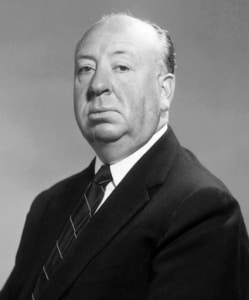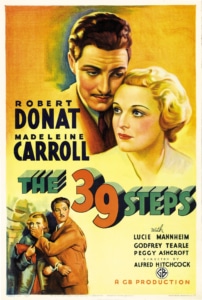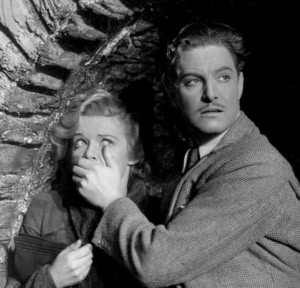DCPA NEWS CENTER
Enjoy the best stories and perspectives from the theatre world today.
Enjoy the best stories and perspectives from the theatre world today.
“I am out to give the public good, healthy, mental shake-ups,” Alfred Hitchcock wrote in 1936, in an essay that might have been a mission statement for his multi-decade film career as the Master of Suspense. “Civilization has become so screening and sheltering that we cannot experience sufficient thrills at first hand. Therefore, to prevent our becoming sluggish and jellified, we have to experience them artificially.”

Alfred Hitchcock
That essay was published a year after the British director completed The 39 Steps, a dashing espionage thriller that not only supplied the requisite jolts, but was arguably the first recognizably “Hitchcockian” film: Here was the Handsome Everyman tangled up mistakenly in a high-stakes international caper; the Icy Blonde hurled by chance into his path and inclined to thaw only after some shared hardship; the Smiling Sophisticate Villain with a seamy retinue of thugs and lackeys; and assorted unsuspecting passersby who might help or hinder our hero, depending on their mood or predilection.
The film’s improbable plot—about rival rings of spies vying over some direly significant state secret—unfurled in a headlong rush, from chase to capture to escape and back to chase again, in a rolling roundelay of mounting danger and derring-do. They set the template for e-ticket movie rides from James Bond to Speed.
“What I like in The 39 Steps are the swift transitions,” Hitchcock later told French director Francois Truffaut. “The rapidity of those transitions heightens the excitement… You use one idea after another and eliminate anything that interferes with the swift pace.”
Now think for a minute: What’s another genre that relies on speed and improbability, crossed wires and missed connections? Funny you should ask: It’s farce, of course. As Pauline Kael astutely noted, the original film is “directed with so sure a touch the suspense is charged with wit.” The family resemblance between the chase thriller and the slapstick comedy will not be news to devotees of Chaplin or Keaton, not to mention Jackie Chan. It turns out that some skilled British farceurs in West Yorkshire, England, apparently also noticed this affinity, and duly turned Hitchcock’s Highland fling into a stage romp that has become an unlikely international hit.
That stage adaptation by actor/writer Patrick Barlow went on to wow the West End, Broadway, off-Broadway, even Madrid before fairly blanketing the U.S. in a tour and a series of original regional renditions.
What’s particularly notable about Barlow’s comic adaptation isn’t just that it’s comic, but that he has pushed the original material just enough to show the underlying humor.
It’s not just that Barlow has dropped in sly visual and verbal references to other Hitchcock films, from Psycho’s shower murder to North by Northwest’s crop duster chase. No, the thing that stands out most about the new stage version is that it’s a kind of tribute from one medium to another: Just as Hitchcock used the full arsenal of cinematic technique to maximum effect in his film, Barlow’s 39 Steps does something similar with the craft of theatre by having just four actors play the whole thing—trains, planes, automobiles, sheep, and all.
One actor plays the put-upon lead, a Canadian bachelor named John Hannay, throughout. But the others are multiple-cast: a woman as three of Hannay’s love interests (including the blonde, Pamela) and two “clowns” who jump in and out of dozens of other characters, from train conductors to policemen to innkeepers to heavies. The gleeful flurry of quick-change characterizations might put one in mind of Charles Ludlam’s The Mystery of Irma Vep—except that most of the changes in The 39 Steps happen, beguilingly, right before our eyes.

Madaleine Carroll and Robert Donat in The 39 Steps
In translating the film to the stage, Barlow has said that he used the screenplay as a blueprint. “I just took the film and then added things that make me laugh,” he said. To give a key example: Hannay and Pamela, handcuffed together by two baddies, must spend the night in a hotel room. Hitchcock includes a famously sexy scene in which Pamela gingerly takes off her stockings while Hannay’s hand flops embarrassedly across her thigh, as well as a charming bit in which sharing sandwiches becomes an awkward hand dance. But while the film retained a British understatement, Barlow wanted to go a bit further.
“I added in [a] kind of mad argument between them,” Barlow said. “That relationship fascinated me, between Pamela and Hannay—the repression of it. Repression is very interesting for a writer to look at. It’s very like Brief Encounter… The Hitchcock film treats the relationship quite lightly, so I added a lot to it.”
If the stage version, then, adds its share of pratfalls, it’s complemented by retaining some of the film’s focus on actual nail-biting suspense. But that’s not to say that the stage version doesn’t elicit side splitting laughter.
Come to think of it, such extreme reactions aren’t too far from the “healthy mental shake-ups” Hitchcock had in mind. There are exceptions (Vertigo and Psycho come to mind), but Hitch mostly intended his filmic jolts to be ultimately pleasing, not unsettling. After all, he also once quipped, “Some films are slices of life. Mine are slices of cake.”
DETAILS
The 39 Steps
Apr 14-Jun 18 • Singleton Theatre
ASL Interpreted and Audio-Described performance: May 7 at 1:30pm
Tickets
